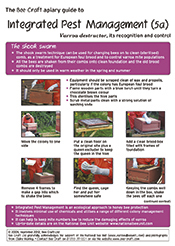The beginning of a new season is the time to assess the health of your colonies as well as the quality of the comb they inhabit.
Old brood comb can be misshapen or have large areas chewed out by the bees. This can make the comb weak, hard to manage and leaves fewer cells available for storing food or raising brood.
Old comb can harbour the pathogens responsible for foul brood diseases, nosema and chalkbrood. It can also store residues from medical treatments, pesticides and other potentially harmful pollutants.
Comb Change Options
There are various approaches to renewing comb in a hive. If your aim is to remove comb which is old or in poor condition, the best choice is to replace a few frames at a time in a programme of ongoing renewal. This allows the bees to build and utilise fresh comb before you replace yet more of the old comb as the season progresses.
Another choice is a Bailey comb change, which allows bees to build new comb in a fresh, clean brood box before the old box and comb is removed.
These techniques are gentle on the bees and do not cause a break in brood-rearing. Sometimes, however, it is desirable to replace all of the old brood comb at once. This could be because you wish to create a temporary broodless period as part of a varroa treatment programme or because the comb itself is a potential harbour for disease such as nosema or European foul brood.
Shook Swarms
Shook swarms are artificial swarms made by shaking all of the adult bees in a colony into a newly cleaned hive that is filled with frames of foundation and, ideally, some clean (Sterilised), drawn comb. This is a disruptive process and means sacrificing all of the existing brood but, if done to a strong colony at the right time of year, the bees will make replacement comb amazingly quickly and may still be able to produce a crop of honey.
The best time to perform a shook swarm is between April and about mid-July, depending on the season and your location.
Shook swarms are the National Bee Unit’s favoured method of controlling outbreaks of European foul brood (EFB), but should only be used to treat this disease under the supervision of your bee inspector.
Equipment Needed
To carry out a shook swarm you will need the following:
- a new or disinfected brood box into which the colony will be transferred
- a second brood box for the temporary storage of frames
- a complete set of new or disinfected frames fitted with foundation and ideally, some clean, drawn comb
- a queen excluder
- a clean floor and crownboard
- a feeder and strong syrup.
When you have finished your shook swarm, the old equipment can be flamed and scrubbed ready for re-use. The old brood frames should be burnt. This destroys any varroa mites reproducing in sealed cells. It also kills any European foul brood bacteria or other pathogens. Once the queen starts laying in the new comb, the queen excluder can be removed from below the brood box. As soon as the first two new combs of brood are sealed, they can also be removed and destroyed, further reducing the varroa population.
Information taken from the Bee Craft Apiary Guide to Integrated Pest Management, available from the Bee Craft online shop.
Article Appears in the April 2018 Edition of Bee Craft Magazine




